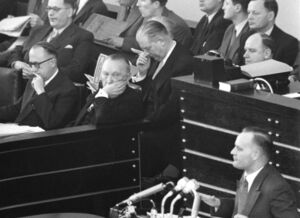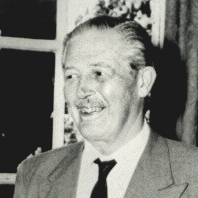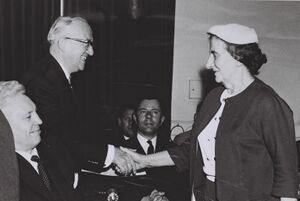Walter Hallstein
(academic, lawyer, diplomat, deep state operative?) | |||||||||||||||||||||||
|---|---|---|---|---|---|---|---|---|---|---|---|---|---|---|---|---|---|---|---|---|---|---|---|
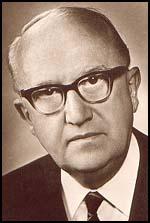 | |||||||||||||||||||||||
| Born | Walther Peter Hallstein 1901-11-17 Mainz, Germany | ||||||||||||||||||||||
| Died | 1982-03-29 (Age 80) Stuttgart, Germany | ||||||||||||||||||||||
| Nationality | German | ||||||||||||||||||||||
| Alma mater | Friedrich Wilhelm University, University of Bonn, University of Munich | ||||||||||||||||||||||
| Party | Christian Democratic Union | ||||||||||||||||||||||
Bilderberg, President of the European Commission
| |||||||||||||||||||||||
Walter Hallstein was a German politician. Having been hand-picked by the allied government after World War 2, he, as foreign minister, led the diplomasc isolation of East Germany. In 1958, he became the first president of the European Commission, a post he held for ten years. During this period he advocated the establishment of the Common Market.
Contents
Background
Walter Hallstein was born on November 17, 1901 in Mainz. The beginning of Hallstein's teenage years coincided with the outbreak of the First World War. At the New Gymnasium in Mainz he was confronted with the war propaganda of that time and, not surprisingly, developed the desire to go into the field as a war hero himself. As part of an engagement with the scouts, he took part in pre-military exercises. To his luck and personal regret, he was spared a combat mission in the First World War.[1]
After graduating from high school, Hallstein studied law in Bonn, Munich and Berlin. After passing the first state examination, he completed a dissertation in 1925 on the “Life Insurance Contract in the Versailles Treaty”.
Career
Hallstein received a teaching position at the Friedrich-Wilhelms-Universität in Berlin and embarked on an academic career, with his doctoral supervisor Martin Wolff and the Austrian Ernst Rabel, newly appointed to Berlin, becoming his sponsors. In 1927, Rabel took Hallstein with him to the renowned Kaiser Wilhelm Institute for Foreign and International Private Law.
Hallstein's excellent academic reputation was demonstrated by the fact that he was appointed to a professorship for economic and commercial law at the University of Rostock on October 1, 1930 - at just 28 years of age he was one of the youngest professors in Germany.
From 1936 until he moved to the University of Frankfurt am Main in 1941, Hallstein also held the position of dean of the Faculty of Law and Economics. In an internal assessment, he was accused of seeing National Socialism rather critically and of not really having internalized the realities since 1933. In his functions as professor and dean, however, he has occasionally made compromises with those in power, but in his speeches and publications there are only relatively few addresses of devotion to the “new era”.
Project Sunflower
After the Allied landings in Normandy, he was taken prisoner by the Americans in June 1944 and was brought to America. At Camp Como camp in Mississippi, he helped set up a camp university and resumed his academic studies. He belonged to a select group of people who received special training from the American authorities as part of the “Project Sunflower”, a reeducation as possible future decision-makers. He also thaught at this camp university. As part of the project, he attended an "administrative school" at Fort Getty, where teaching included the principles of the Constitution of the United States. Hallstein remained a prisoner of war from June 1944 to mid-1945.[2]
Hallstein came back to Germany in November 1945. In the heavily destroyed financial center, he helped to enable the reopening of the University of Frankfurt. What he was aiming for in 1945 he was able to achieve three years later: he took on a visiting professorship at Georgetown University in Washington DC for a year. During this time he was able to make important contacts with American scientists and politicians and became part of the early Cold War tie between Americans and West Germans establishing transatlantic networks.
State Secretary at the Foreign Office (1951–1958)
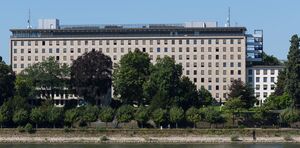
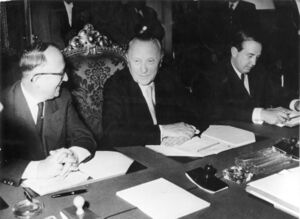
Following a change in the Occupation Statute, the German Foreign Office was re-created in March 1951, but the post of Foreign Minister was filled by Adenauer himself. On 2 April 1951, Hallstein was made the leading civil servant at the newly created Foreign Office.
Foreign policy continued to be managed by Adenauer himself with his group of intimates, including Hallstein, Blankenhorn and others. In many respects Hallstein was the West German Foreign Minister in all but name, but there was a growing awareness that a separate officeholder was needed.
Hallstein played an important part in promoting West Germany's goals of regaining sovereignty and creating a European Defence Community (EDC), of which West Germany would be a member.[3] Negotiations at first resulted in two international agreements:
- On 26 May 1952, the Treaty of Bonn was signed by the United States, United Kingdom, France, and West Germany; on ratification, it would largely restore sovereignty to the Federal Republic of Germany (de facto West Germany, but not including West Berlin, which retained a special status).
- On 27 May 1952, the Treaty of Paris was signed by the United States, France, Italy, Belgium, Netherlands, Luxembourg, and West Germany; on ratification, it would have established the European Defence Community (EDC).
However, the Treaty of Paris failed to obtain the necessary approval of the French Parliament. Instead, a solution involving the Western European Union (WEU) was agreed, and West Germany was to become a member of NATO. The efforts to resolve the issues culminated, in 1954, in a series of conferences in London and Paris. The German side was represented by Adenauer, the German chancellor, together with the top civil servants at the German Foreign Office: Hallstein, his colleague Blankenhorn, and his deputy, Grewe. Hallstein helped negotiate various treaties at the London Nine-Power Conference from 23 September to 3 October 1954; they were finalized at the Paris conference from 20 to 23 October 1954. The conferences in Paris included a meeting of the parties to the Nine-Power Conference in London (20 October), a meeting of the seven WEU members (20 October), a meeting of the Four Powers to end the occupation of Germany (21–22 October), and a meeting of all fourteen NATO members to approve Germany's membership.
After the ratification of the Paris Accords on 5 May 1955, the General Treaty (Deutschlandvertrag), which largely restored (West) German sovereignty, took full effect; the Federal Republic of Germany became a member of NATO.
Once the major foreign policy objectives were in hand, Hallstein set about restoring Germany's diplomatic service and re-organizing the Foreign Office, based on the findings of the Maltzan Report, a report commissioned by Hallstein on 26 June 1952 and produced a month later by Vollrath Freiherr von Maltzan, a former diplomat, at that time on loan from the Ministry of Economics.
There was criticism of a lack of information and consultation and an atmosphere of secrecy, possible resulting from Adenauer's distrust of the old hands at the Foreign Office, the Wilhelmstraße veterans, as well as the desire to fill top jobs with outsiders not tainted by having served as diplomats under the Nazis.
There were suggestions of a disconnect between the leadership (consisting of Adenauer and a small group of close advisers, including Hallstein and Blankenhorn) on the one hand and the division leaders at the Foreign Office and the diplomatic missions on the other. In particular, Hallstein was also criticised in the press after the European Defence Community was rejected by the French National Assembly, as had been predicted by the German diplomatic mission in Paris.
On 6 June 1955, Adenauer, who had until then been Foreign Minister as well as Chancellor, appointed Heinrich von Brentano foreign minister and there was a reshuffling of responsibilities, but Hallstein retained the trust of Adenauer and continued to attend cabinet meetings.[4] Herbert Blankenhorn, who until then been the head of the Political Department of the Foreign Office, became the German Permanent Representative to NATO in Paris; Wilhelm Grewe took over the Political Department under Hallstein and was made Hallstein's deputy.
Hallstein was involved in discussions with the French concerning the return of the coal-rich Saar to Germany. In October 1955 there was a referendum held to decide whether the Saar would remain separate from Germany or be re-integrated into Germany, following which it was agreed with France that there would be political integration into the Federal Republic of Germany by 1 January 1957 and economic integration by 1 January 1960. In September 1956, Hallstein announced that France had agreed to hand over control of the Saar to Germany; on 27 October 1956, the Saar Treaty was signed.
Hallstein Doctrine
In 1955, Germany had in large measure regained its sovereignty and become integrated into western defence-organizations, the WEU and NATO; European integration had progressed, with the establishment of the ECSC; the Saar question was to be resolved by the referendum in October 1955. In all of these matters, Hallstein had played a major role.
Some of the main issues of German foreign policy were now German re-unification and the relations of West Germany (the Federal Republic of Germany) with its eastern neighbours, including East Germany (the German Democratic Republic). Being more involved in Western European integration, Hallstein delegated much of this work to his deputy, Wilhelm Grewe. But in this area particularly, German foreign policy became associated with the name Hallstein.
In 1955, Hallstein and Grewe accompanied Adenauer as members of a delegation to Moscow, where the establishment of diplomatic relations between Bonn and Moscow was agreed. It was on the flight back from Moscow that the policy that was later to become known as the Hallstein Doctrine was fleshed out, though the Foreign Office had already devised and practised elements of the policy.The idea behind the Hallstein Doctrine came from Hallstein's deputy, Wilhelm Grewe. The doctrine would become one of the major elements of West German foreign policy from September 1955;– until official recognition of the German Democratic Republic in October 1969.
Based on the Basic Law, its de facto constitution, the Federal Republic of Germany;– then commonly known in the English-speaking world as West Germany;– claimed an exclusive mandate to represent the whole of Germany, including the Communist East Germany, which was aligned with the Soviet Union. One of the early objectives of West German foreign policy was the diplomatic isolation of East Germany. In 1958, journalists named this policy the Hallstein–Grewe Doctrine, which later became shortened to the Hallstein Doctrine.
Grewe himself writes that he did devise the broad outlines of the policy, but mainly as one of a number of options, the decisions being made by the foreign minister, Brentano, and the chancellor, Adenauer; in any case, the name Hallstein doctrine may have been something of a misnomer.
No official text of the so-called "doctrine" was made public, but it was explained publicly in a radio interview[5] by its main architect, Wilhelm Grewe. Adenauer also explained the outlines of the policy in a statement to the German parliament on 22 September 1955.
It meant that the Federal German government would regard it as an "unfriendly act" if third countries were to recognize or maintain diplomatic relations with the "German Democratic Republic" (East Germany). The exception was the Soviet Union, as one of the Four Powers responsible for Germany. The threatened response to such an unfriendly act was often understood to mean breaking off diplomatic relations; this was not stated as an automatic response under the policy, but remained the ultima ratio.
European integration and the Rome treaties
Members of the German government had different positions on European integration. Hallstein and his team at the Foreign Office advocated a federal solution with a form of "constitutional integration" broadly based on the European Coal and Steel Community, with the scope gradually increasing to include additional sectors, and with true parliamentary representation of the European populace.[6] Hallstein contended that institutional integration was in the interests of a successful German export industry.[7] Ludwig Erhard and the Ministry of Economics argued for a looser "functional integration" and advocated intergovernmental economic co-operation. Erhard opposed supranational structures and characterized the Foreign Office proponents of a federal Europe as out of touch with economic realities.[8] In the dispute, Adenauer finally supported Hallstein,[9] settling the acrimonious, and public, conflict between Hallstein and Erhard.[3]
In 1955 the foreign ministers of the European Coal and Steel Community met at the Messina Conference, among other things to nominate a member of the High Authority of the European Coal and Steel Community and to appoint its new president and vice-presidents for the period ending 10 February 1957. The conference, which was held from 1 to 3 June 1955 in the Italian city of Messina, Sicily, would lead to the signing of the Treaty of Rome in 1957. Shortly before the conference, Adenauer had given up his double post as Foreign Minister and, since Brentano had not yet been sworn in, Hallstein led the German delegation. The agenda included discussion of an action programme to relaunch European integration following the collapse, in August 1954, of the plans to create a European Political Community and a European Defence Community, when France failed to ratify the treaty.[10]
On 6 September 1955, shortly before Adenauer's trip to Moscow, Hallstein, standing in for Brentano, attended the Noordwijk Conference of foreign ministers convened to evaluate progress made by the Spaak Committee.[11] On 9 November 1955, Hallstein reported the results to the West German Cabinet, where the Ministry of Economics and the Ministry of Agriculture opposed the plans for a common market rather than a free trade area. The Ministry of Economics feared that a customs union meant protectionism; the Ministry of Agriculture was concerned that the interests of German farmers would be betrayed; Franz Josef Strauss opposed the perceived discrimination against German industry regarding access to uranium.[11] Finally, the chancellor, Adenauer, again settled the dispute between the ministries by a decision in favour of Hallstein and the Foreign Office.[12] When the Spaak Report (the Brussels Report on the General Common Market) was finally presented in April 1956, it recommended a customs union. In the Cabinet meeting of 9 May 1956 there was renewed opposition to the position of the Foreign Office from other ministers, but Adenauer lent his support to Hallstein, and the Cabinet authorized intergovernmental negotiations, to be held at the conference of foreign ministers in Venice at the end of May, the German delegation again to be led by Hallstein.[12]
In July 1956, Britain had made proposals for the Organisation for European Economic Co-operation (OEEC) to examine the possibility of a free trade area for industrial goods.[13] The French, mainly interested in Euratom, attempted to separate the debate on the two topics and proposed a compromise treaty under which only the general principles of a common market would be agreed, leaving details to be decided later,[14] but Germany made negotiations on Euratom dependent on negotiations on a common market.[12] At the Venice Conference, the French foreign minister, Christian Pineau agreed to intergovernmental negotiations, with three provisos: the economic community was to be established in stages; customs tariffs should be reduced by only 30%; and national governments should not be overly constrained with regard to economic policy. Hallstein warned against accepting the French terms, which in his view meant that the French would push for a quick decision in favour of Euratom and delay the negotiations on the common market.[15] Hallstein was supported by the foreign ministers of the Netherlands and Luxembourg, against France, in demanding a fixed deadline and timetable for the establishment of a common market.[15] The French National Assembly approved the commencement of intergovernmental negotiations in July 1956, after the prime minister, Guy Mollet, gave an assurance that Euratom would not impose restrictions on the French nuclear weapons programme.[13]
Another cause of disagreement was the inclusion of French overseas territories in any common market. Erhard strongly opposed this, partly because of the perceived danger of France involving the other member states in its colonial responsibilities. The Foreign Office shared these concerns to some extent but Hallstein and Carstens were willing to accept the French position, believing it would help gain support from the French National Assembly; Hallstein also accepted the argument of his French counterpart, Faure, that it would benefit Germany.[16] Hallstein helped to strike a deal by which the imports and exports of overseas territories would be treated like products of the mother country and private investment and company branches of other member states would be permitted, thus opening up the overseas territories for German exports. Hallstein helped deal with these problems at two conferences of foreign ministers, one from 26 to 27 January 1957 and another on 4 February.[17]
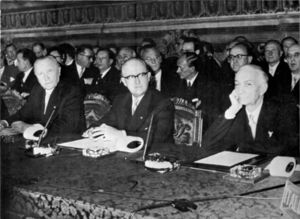
On 25 March 1957, the six countries Belgium, France, Germany, Italy, Luxemburg, and Netherlands signed the Treaties of Rome. Adenauer and Hallstein signed for Germany.[18] The foreign minister, Brentano had largely left the negotiations to Hallstein, so the signing of the treaty represented a major success for Hallstein.[17] It was also Hallstein who explained the treaties to the German parliament on 21 March 1957, before they were signed on 25 March 1957.[17]
Choosing the President of the Commission
There had been previous suggestions of Hallstein becoming president of the European Court,[19] but now he was put forward as the German candidate for the president of the Commission, though the Belgian Minister of Economics, Rey and the Netherlands Agriculture Minister, Mansholt were regarded as the strongest contenders for the position.[20] The conference of foreign ministers on 20 December 1957 could not reach a decision, so when the Treaties of Rome took effect on 1 January 1958, the position had not been filled. At the conference of foreign ministers on 6 and 7 January 1958, however, Hallstein was finally chosen as the first president of the EEC Commission.[20] Hallstein's selection for this position at the head of a major European organization, a decade after the end of World War II, was a major achievement for Germany.[20]
President of the Commission of the European Economic Community (1958–1967)
Laying the foundations of the EEC
Barely a decade after the end of World War II, the German Walter Hallstein was unanimously elected the first president of the Commission of the European Economic Community (now the European Commission) in Brussels.[21] He was elected on 7 January 1958,[22] and he was to remain in the position until 1967.[23]
Hallstein's commission, which held its first meeting on 16 January 1958,[24] comprised nine members (two each from France, Italy and Germany, one each from Luxembourg, Belgium and the Netherlands).[25] The tasks it faced included the implementation of a customs union and the Four Freedoms, as well as common policies on competition, trade, transport and agriculture.[26]
Hallstein famously described his role as "a kind of European prime minister" and regarded national sovereignty as a "doctrine of yesteryear."[27] Though Hallstein's personal vision of a federal Europe was clear, the EEC treaty left many questions open. Opinions were divided, for instance, on whether a common market could succeed without a common economic policy, on enlargement of the European Union – in particular whether Britain should join – and whether the final goal should be a political union in the sense of a "United States of Europe".[28]
Differing interests and traditions in the member states and differences of opinion among the politicians meant that consensus was difficult. The disagreements that had preceded the creation of the EEC continued after it was established, and these were reflected within the Commission. For instance, the protectionist Common Agricultural Policy (CAP), the responsibility of Sicco Mansholt, the Commissioner for Agriculture, was at odds with the liberal foreign trade policy of the Commissioner for External relations, Jean Rey.[29]
Britain had at first been against the formation of the EEC, preferring a looser free trade area, and later proposed a larger free trade area that would include the EEC and other European countries. The German government, German industry, and – especially – the Economics Minister, Ludwig Erhard, wanted Britain to be part of an integrated Europe. Hallstein opposed the idea of a wider free trade area at this time, advocating first achieving a greater degree of integration among a smaller number of countries.[30] Discussions on the possibility of a wider trade area, avoiding the tariff wall between the EEC and the EFTA countries, continued, but in the middle of preparations for the negotiations the French government, on instructions from de Gaulle, withdrew. This unilateral action by the French in November 1958 displeased the other EEC members and effectively ended the negotiations. German politicians like Erhard felt that Hallstein and his commission had not done enough to promote the wider free trade area.[28]
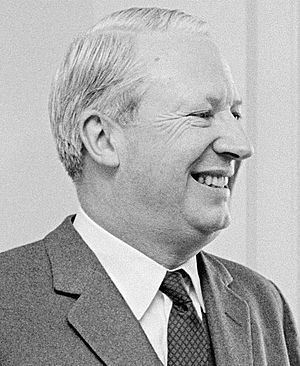
The six countries of the EEC had decided on a customs union: they agreed to remove tariffs between one another within a period of twelve years, and to erect a common tariff barrier between themselves and other countries. Seven of the excluded European countries (United Kingdom, Sweden, Denmark, Norway, Switzerland, Austria, and Portugal) responded with an alternative free trade area, EFTA, which also removed tariff barriers between each other, but did not insist on a tariff barrier with other countries. The EFTA convention was signed in January 1960 and was to come into force in May 1960.[31] On 3 March 1960, Hallstein announced a plan for accelerating the implementation of the common market, which commentators regarded as sabotaging hopes of a joint free trade area that included the EEC and EFTA. This invoked the displeasure, not only of the EFTA countries, but also of the Economics Ministry under Erhard.[32] Commentators talked of Hallstein's "religious zeal".[32]
In 1961 Harold Macmillan, the British Prime Minister, finally gave up the idea of the larger free trade area, and the United Kingdom applied to join the EEC. Edward Heath, as Lord Privy Seal in the Macmillan government, led the negotiations in Britain's first attempt to join the EEC. Hallstein, as president of the EEC Commission, was cautious, considering the British application premature.[33] Of British politicians, only Heath was able to establish a rapport with Hallstein.[34] The Financial Times (of 2 August 1961) wrote that Hallstein was one of the least enthusiastic about British membership of the EEC.[35] In British government circles he was at first seen as siding with the French and de Gaulle, against Britain and the other five members of the EEC, who were more welcoming to Britain, and as favouring the French protectionist position.[36] Elements of the British Press, notably the Daily Express, were critical of Hallstein – or what he represented.[37]
It was in 1961 that de Gaulle proposed the Fouchet Plan, a plan for an intergovernmental "union of states", as an alternative to the European Communities. There was little support from the other European countries, and negotiations were abandoned on 17 April 1962.[38]
While Hallstein had a decidedly federal vision for Europe, and regarded the Commission as a quasi-federal organ,[39] de Gaulle's vision was of a confederation.[40] From the beginning, Hallstein did not believe that de Gaulle's approach of cooperation between sovereign nation states would be able to realize his vision of a powerful Europe that could play its proper part on the world stage.[39]
De Gaulle also envisaged a pooling of sovereignty in certain areas, such as external defence, harmonization of industrial production and foreign trade, currency, exploitation of resources in overseas territories, and cultural and scientific development,[41] but at the same time he was developing the French nuclear deterrent capability, the Force de Frappe, which he envisaged as part of a European defence capability independent of the United States.[40] This independence from the United States was one of de Gaulle's main objectives; he was against the increased integration of Europe under the umbrella of transatlantic integration as provided for in the Rome treaties.[38]
The Hallstein Commission drew up plans and a timetable for an economic and currency union, and Hallstein presented these to the Council of Ministers and the European Parliament in October 1962.[42]
A second attempt by de Gaulle to establish a closer political union in Europe that would be independent of the United States was the Franco-German bilateral treaty on political cooperation. This treaty between France and Germany, which was signed on 22 January 1963, was criticized by other countries as being incompatible with the EEC and NATO treaties. Hallstein and other members of the Commission also criticized the treaty, and this angered de Gaulle.[28] When the treaty was ratified by West Germany, the German Bundestag unilaterally added a preamble that re-affirmed the commitment to close transatlantic ties, the enlargement of the existing European Communities and attempts to secure Britain's accession. Since Britain had firmly expressed its unwillingness to support an autonomous European defence independent of America, de Gaulle regarded the treaty as a failure.[38]
Further attempts by de Gaulle at military cooperation with Germany to the exclusion of America were rebuffed by Erhard (now Federal Chancellor) and his foreign minister Gerhard Schröder.[38] Britain's application for membership of the EEC was vetoed by de Gaulle in 1963, which also further antagonized the other participants.[38]
Confrontation with de Gaulle
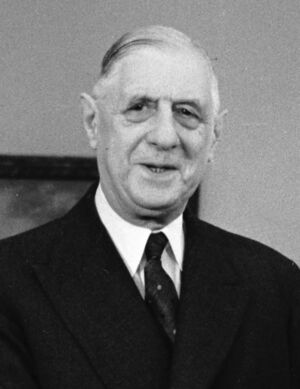
De Gaulle took a confrontational course on the Common Agricultural Policy, and on 21 October 1964, the French Minister of Information, Alain Peyrefitte announced that France would leave the EEC if the European Agricultural market were not implemented in the agreed form by 15 December 1964.[43] On 1 December 1964, Erhard, now head of government in Germany, announced that Germany would accede to French demands for a common wheat price, and on 15 December the Council of Ministers laid down common grain prices from 1 July 1967 and instructed the Commission to submit proposals for financing the Common Agricultural Policy (CAP) by 1 July 1965.[43]
Differences between France and the Commission – and especially between de Gaulle and Hallstein – were exacerbated when France held the rotating six-month Presidency of the Council, from January to June 1965.[44]
The Council of Ministers instructed the Commission to submit plans by 1 April 1965 on how to finance the Common Agricultural Policy as from July 1965, including its financing from direct levies rather than national contributions; this would entail a transfer of revenues to the Community. [43] The ministers representing other countries, in particular the Netherlands, indicated that their national parliaments would not approve transfer of revenues to the Community unless the rights of the European Parliament were strengthened.[43] On 20 January 1965, the European Parliament passed a resolution appealing to the governments to take this step toward strengthening a democratic and federal Europe.[43] Hallstein supported this.[45] Hallstein had received indications that other countries shared his point of view and decided to risk the confrontation with de Gaulle, interpreting the instructions from the Council broadly, with the support of Dutch Commissioner for Agriculture, Sicco Mansholt.[45] The majority of the commission backed Hallstein.[45]
On 24 March 1965, Hallstein presented the Commission's proposals for financing the Common Agricultural Policy (CAP) to the European Parliament. It was proposed that customs duties collected at EEC borders would go to the community budget and that the Common Agricultural Market would be implemented as scheduled on 1 July 1967 – but the customs union for industrial products would also be implemented at the same time, two and a half years earlier than provided for in the Rome Treaty.[46] The proposals would have allowed the Community to develop its own financial resources independently of the member states and given more budgetary powers to the European Parliament.[44] From 1 January 1966, voting in the Council was to be by simple majority, removing the implicit veto power of individual countries. The French government stated it could not agree to this.[47]
Since the legislation would increase not only the Commission's powers, but also the Parliament's, Hallstein had the support of the Parliament, which had long been campaigning for more powers. Before the proposals were presented to the Council, they became public, and Hallstein then presented them to the European Parliament on 24 March, a week before presenting them to the Council. When Hallstein put forward his proposals, the Council was already concerned.[47] France rejected the idea of the increased powers for the European Parliament and of the Community having its own independent revenues, insisting that what had been agreed by the Council regarding the financing of the common agricultural policy be implemented by 30 June 1965.[48] He accused Hallstein of acting as if he were a head of state. [44] France was particularly concerned about protecting the CAP because – under a majority system – it could be challenged by the other members.[44]
After discussions between France and Germany, a compromise was at first reached, postponing implementation of the agricultural levies until 1970, [49] but at the Council meeting of 28 June the Netherlands foreign minister, Joseph Luns, and his Italian counterpart, Amintore Fanfani, insisted that all of the Commission's proposals should be discussed as a package.[49] German diplomats supported this position, and the German Bundestag passed a resolution stating that the Commission's proposals did not go far enough; Germany did not want to agree to the plans for agricultural financing without being assured that France would not hinder a general reduction in tariffs in the Kennedy Round.[50]
The Committee of Permanent Representatives of the foreign ministers produced a report recommending a compromise by making both the agricultural levies and the customs duties available to be used for Community purposes but not centralizing the process; however, Hallstein refused to broker this deal, and suggested employing the common practice of "stopping the clock" until the issue could be resolved.[50]
Under pressure from Couve de Murville, who was the rotating President of the Council at the time, Hallstein agreed, on 30 June 1965, to work out a compromise. The same day, however, after consulting with de Gaulle, Couve de Murville announced that no agreement had been reached by the agreed deadline and that the negotiations had failed. France's presidency of the Council, which rotated every six months, terminated on 30 June 1965.[50]
Empty Chair Crisis
A few days later, on de Gaulle's instructions, France ceased participation in all meetings of the Council of Ministers and the Council of Permanent Representatives that dealt with any new decisions. Participation in many working groups ceased, and the French Permanent Representative to the EU, Jean-Marc Boegner was recalled, together with 18 high-ranking civil servants and diplomats.[51][52]
In an attempt to resolve the situation, Hallstein, together with Marjolin, the (French) vice-president of the Commission, drew up a new plan, continuing the provisional arrangement for agricultural finances until 1 January 1970. This proposal was presented to the Council on 22 June 1965.[53]
De Gaulle, however, remained confrontational toward Hallstein and the Brussels "technocrats". In September 1965, he publicly declared his opposition to majority voting and the political role of the Commission. [53] Since a treaty change required unanimity, there was stalemate,[54] and there was no provision in the treaties to cover such a boycott of the normal running of the Community.[53] At least in Hallstein's eyes, it was a breach of treaty obligations, and he was unprepared for such a scenario.[55]
On 20 October 1965 Couve de Murville, in the National Assembly, pushed for a revision of the treaties; this was opposed by the other five member states. At the Council meeting of 25 to 26 October they passed a resolution stating that a solution "must be found within the provisions of the existing treaties".[56][53] As a compromise, however, they offered the possibility of an extraordinary meeting of the Council to discuss "the general situation of the Community" – without the Commission being invited.[57]
Following the French presidential elections on 5 November and 19 December 1965, de Gaulle accepted this offer. In the negotiations on 17/18 January 1966, the French foreign minister, Couve de Murville, dropped the more extreme of France's demands.[58]
In January 1966, the six foreign ministers agreed to suggest to the Commission that the Permanent Representatives of the ministers should be consulted before making any major proposals and not to publish such proposals before they had been dealt with by the Council of Ministers. The other five took note of – but did not formally accept – the opinion of the French delegation that for matters of very important national interest, the discussion should continue until a unanimous agreement was reached.[58]
This became known as the Luxembourg Compromise.[58] It was not specified what could be invoked as a national interest and how to resolve disputes, so majority decisions were avoided and – until it was abolished by the Single European Act – it became a de facto veto, requiring unanimity for Council decisions.[59] Some concessions were also made to French sensibilities; for instance, diplomats no longer presented their credentials to Hallstein alone but jointly to the presidents of the Commission and the Council.[60]
When the "Empty Chair Crisis" was finally resolved, it had lasted from 30 June 1965 to 29 January 1966.[55]
When the French foreign minister Couve de Murville returned to the negotiating table after Hallstein's official term of office in January 1966, he insisted on Hallstein's departure and the nomination of someone else to be the head of the new commission, which would in future be the commission shared by all three communities when the EEC, the ECSC, and Euratom were merged.[61]
Since there was no agreement on a replacement for Hallstein when his term ended on 8 January 1966, he remained in office as a caretaker (based on Article 159 of the EEC Treaty). This also meant that the planned merger of the three communities, which was to have taken place on 1 January 1966, was postponed. [62][60]
In view of the confrontation with de Gaulle, there was a proposal that Hallstein should be nominated for a further term but that he should serve for only six months. The German Chancellor, Georg Kiesinger agreed to this compromise, but Hallstein considered this was a breach of the Treaty[63] and on 5 May 1967 he asked not to be re-nominated at all.[58]
In this way, the national governments had refused to accept the commission becoming a European executive, blocking Hallstein's vision of a United States of Europe.[64]
Issues behind confrontation with de Gaulle
De Gaulle recognized Hallstein's service to the European idea, but attributed it to German patriotism, serving the interests of Germany, enabling Germany to re-attain a respect and status in Europe that it had lost because of Hitler. De Gaulle resented the status that Hallstein, for him a mere technocrat, was accorded by foreign states. [65][66] Hallstein, for his part, was watchful that, as representative of the Commission, he was accorded the status normally accorded to a head of state.[67][66] De Gaulle complained of the Commission usurping a political role reserved for governments and of Hallstein usurping a role reserved for heads of government or heads of state; he attacked Hallstein personally saying that Hallstein was trying to turn the EEC into a superstate, with Brussels as its capital; he talked of defending French democracy against an unaccountable and stateless technocracy, "a technocratic Areopagus, stateless and unaccountable" [De Gaulle at a press conference at the Elysée Palace on 9 September 1965.
In his memoirs, De Gaulle wrote of Hallstein
He was ardently wedded to the thesis of the super-State, and bent all his skilful efforts towards giving the Community the character and appearance of one. He had made Brussels, where he resided, into a sort of capital. There he sat, surrounded with all the trappings of sovereignty, directing his colleagues, allocating jobs among them, controlling several thousand officials who were appointed, promoted and remunerated at his discretion, receiving the credentials of foreign ambassadors, laying claim to high honors on the occasion of his official visits, concerned above all to further the amalgamation of the Six, believing that the pressure of events would bring about what he envisaged.
—De Gaulle, Memoirs of Hope[66]
According to Der Spiegel, De Gaulle's complaints included[68]
- Hallstein's being frequently received by US presidents, although the Commission had no foreign relations mandate;
- Hallstein's claim to be a sort of European prime minister;
- the rank of ambassador held by the representatives of the 65 states accredited with the European Commission;
- foreign ambassadors' presentation of their credentials to Hallstein (ambassadors normally present their credentials, signed by the countries head of state to the head of state of the host country);
- the participation of Commission staff in the Kennedy Round negotiations in Geneva, in negotiations with EFTA, and in negotiations with non-European states, in particular South American states.
On the political role of the Commission, Hallstein stated in an interview with Der Spiegel {{Quote|text=In principle, we have no political competences ... because there is nothing of that nature in the Rome Treaty. But we have political responsibility because we are a political – not an economic – enterprise. The Common Market has the goal of unifying Europe politically. The issue that triggered the Empty Chair Crisis was the financing of the common agricultural policy, which was of critical interest to France: from 1962 to 1964, France had received 46 million US dollars from the agricultural fund, eighty-five per cent of all revenue.[69]
The clash between Hallstein and de Gaulle demonstrated a clash between two opposing visions of Europe.[70] The differences included:
- the debate on inclusion of the United Kingdom
- the financing of the Common Agricultural Policy
- the rights of the European Parliament, especially with respect to the budget
- majority voting in the Council of Ministers.
On most of these issues, de Gaulle regarded Hallstein as an opponent. Hallstein's response to de Gaulle's attacks was also somewhat confrontational, comparing de Gaulle's actions with those of Hitler.
Later life (1967–1982)
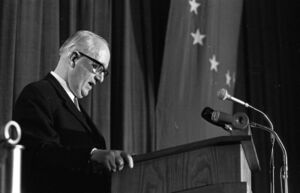
Hallstein left the Commission at the end of 1967, aged 68.[63]
On 20 January 1968, Hallstein was elected president of the European Movement, a private organization founded in 1948 as the umbrella organization of various organizations in favour of European integration, [71] where he continued to promote his vision of a "United States of Europe".[72] Hallstein retained this office until 1974, when he did not stand for re-election, being followed by Jean Rey, who had also succeeded him as President of the Commission.[73][21]
In the run-up to the federal elections in 1969, Helmut Kohl, then minister-president and head of the CDU in the state of Rhineland Palatinate offered Hallstein the opportunity of standing as a direct candidate in the Neuwied constituency in the Westerwald area and heading up the CDU party list in the state of Rhineland Palatinate. At the time, the CDU under Kurt Georg Kiesinger was the governing party. At the CDU "Euroforum 68" congress in Saarbrücken in January 1968, Hallstein was celebrated as the future foreign minister, should the CDU win the 1969 federal election.[74] He proposed to confront de Gaulle and counter his attempts to "devalue" and "weaken" the European Community.[74] However, the party lost the election, leaving Hallstein as a member of the Bundestag, but with no government office.[75]
As reported by Der Spiegel, Hallstein was later approached by Kohl as a possible candidate to replace Heinrich Lübke as Federal President, but this did not come to fruition. [76] From 1969 to 1972, he was a member of the German Federal Parliament for the Christian Democratic Union,[21] where he was on the Foreign Affairs Committee and was one of the party's spokesmen for European affairs, along with Erik Blumenfeld and Carl-Ludwig Wagner. In the party, he supported the Junge Union, the CDU youth organization. Hallstein had little personal contact with his constituency, the work being done mainly by his assistant Christian Franck. At the next elections in 1972, he was not re-nominated.[75] In his speeches in the Bundestag, he continued to express his vision of European union. He also spoke out in favour of direct election of the European Parliament in Germany. At that time, the members of the European Parliament were delegated by the Bundestag, and direct election was not introduced until 1979.[77]
Having left the Bundestag in 1972 and the presidency of the European Movement in 1974, Hallstein retired from active political life but continued to write and give talks. He moved from his country house in the Westerwald to Stuttgart, and continued his work as an author.[21]
Hallstein fell ill in early 1980[78] and died in Stuttgart on 29 March 1982, at the age of 80.[23] He was buried, following a state funeral,[79] on 2 April 1982[80] at the Waldfriedhof Cemetery in Stuttgart.[21]
Hallstein remained a bachelor all his life.[80]
Events Participated in
| Event | Start | End | Location(s) | Description |
|---|---|---|---|---|
| 1948 Hague Congress | 7 May 1948 | 11 May 1948 | Netherlands The Hague | Landmark conference which had a profound influence on the shape of the European Movement. Many of the groups organizing the conference received covert funding from the CIA. |
| Bilderberg/1955 September | 23 September 1955 | 25 September 1955 | Germany Bavaria Garmisch-Partenkirchen | The third Bilderberg, in West Germany. The subject of a report by Der Spiegel which inspired a heavy blackout of subsequent meetings. |
| Bilderberg/1956 | 11 May 1956 | 13 May 1956 | Denmark Fredensborg | The 4th Bilderberg meeting, with 147 guests, in contrast to the generally smaller meetings of the 1950s. Has two Bilderberg meetings in the years before and after |
| Bilderberg/1958 | 13 September 1958 | 15 September 1958 | United Kingdom Buxton UK | The 7th Bilderberg and the first one in the UK. 72 guests |
References
- ↑ https://www.konrad-adenauer.de/personen/h/hallstein-walter
- ↑ Freiberger, Thomas (2010). "Der friedliche Revolutionär: Walter Hallsteins Epochenbewusstsein" page 225
- ↑ a b Elvert 2011.
- ↑ Lahn 1998, p. 25.
- ↑ http://www.1000dokumente.de/index.html?c=dokument_de&dokument=0019_hal
- ↑ Küsters, Hanns Jürgen (1998). "Walter Hallstein and the Negotiations on the Treaties of Rome 1955–57". In Loth, Wilfried; Wallace, William; Wessels, Wolfgang (eds.). Walter Hallstein: The Forgotten European?. Forewords by Jacques Delors, Sir Edward Heath, and Helmut Kohl; translated from the German by Bryan Ruppert. New York: St. Martin's Press. pp. 60–81
- ↑ Küsters 1998, p. 65.
- ↑ Küsters 1998, pp. 68–69.
- ↑ Maulucci 2012, p. 142.
- ↑ Griffiths 1994, pp. 20–40.
- ↑ a b Küsters 1998, p. 69.
- ↑ a b c Küsters 1998, p. 70.
- ↑ a b Küsters 1998, p. 71.
- ↑ Küsters 1998, p. 72.
- ↑ a b Küsters 1998, pp. 70–72.
- ↑ Küsters 1998, pp. 73–74.
- ↑ a b c Küsters 1998, p. 74.
- ↑ Piela 2010, p. 3.
- ↑ Maulucci 2012, p. 195.
- ↑ a b c Küsters 1998, p. 75.
- ↑ a b c d e Piela 2010, p. 7.
- ↑ German Foreign Office.
- ↑ a b German Historical Museum.
- ↑ Hallstein 1958.
- ↑ Dumoulin 2007, p. 51.
- ↑ Groeben 1998, pp. 101–102.
- ↑ Soetendorp 2014, p. 20.
- ↑ a b c Groeben 1998, pp. 97–101.
- ↑ Groeben 1998, p. 103.
- ↑ Groeben 1998, p. 100.
- ↑ Sloan 2005, p. 300.
- ↑ a b Spiegel 1960.
- ↑ Narjes 1998, p. 127.
- ↑ Wallace 1998, p. 182.
- ↑ Wallace 1998, p. 193.
- ↑ Wallace 1998, pp. 193–195.
- ↑ Wallace 1998, p. 194.
- ↑ a b c d e Loth 1998, p. 139.
- ↑ a b Groeben 1998, pp. 96–97.
- ↑ a b Loth 1998, pp. 137–138.
- ↑ Loth 1998, p. 137.
- ↑ Groeben 1998, p. 98.
- ↑ a b c d e Loth 1998, p. 140.
- ↑ a b c d CVCE 2011.
- ↑ a b c Loth 1998, p. 141.
- ↑ Loth 1998, p. 142.
- ↑ a b Ludlow 2006.
- ↑ Loth 1998, pp. 142–143.
- ↑ a b Loth 1998, p. 143.
- ↑ a b c Loth 1998, p. 144.
- ↑ Götz 1998, p. 157.
- ↑ Loth 1998, pp. 144–145.
- ↑ a b c d Loth 1998, p. 145.
- ↑ Groeben 1998, p. 99.
- ↑ a b Götz 1998, p. 151.
- ↑ van Middelaar 2013.
- ↑ Loth 1998, pp. 145–146.
- ↑ a b c d Loth 1998, p. 146.
- ↑ CVCE 2012.
- ↑ a b Spiegel 1967a.
- ↑ Spiegel 1966b.
- ↑ Geary 2013, p. 65.
- ↑ a b Jansen 1998, p. 165.
- ↑ Loth 1998, p. 147.
- ↑ Loth 1998, p. 148.
- ↑ a b c De Gaulle 1971, p. 184.
- ↑ Götz 1998, p. 154.
- ↑ Spiegel 1966a.
- ↑ Spiegel 1965b.
- ↑ Götz 1998, pp. 151–152.
- ↑ Piela 2012, p. 42.
- ↑ Jansen 1998, p. 166.
- ↑ Jansen 1998, p. 167.
- ↑ a b Spiegel 1968a.
- ↑ a b Jansen 1998, pp. 171–173.
- ↑ Spiegel 1968b.
- ↑ Jansen 1998, p. 175.
- ↑ Kilian M 2005, pp. 376–377.
- ↑ Jansen 1998, p. 179.
- ↑ a b Kilian M 2005, p. 374.
Wikipedia is not affiliated with Wikispooks. Original page source here
